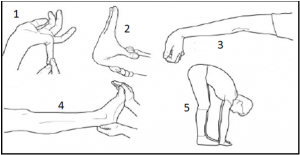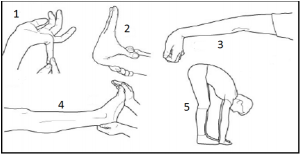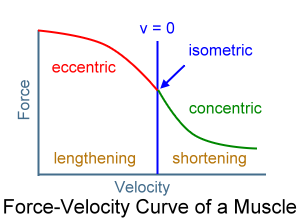Last week Okanagan Peak Performance Inc hosted a seminar for the gymnastics community. The title was The Most Important Ability for Gymnasts - What it is and how to improve it. Below is a brief recap of the seminar.Probably about 15 years ago I did a clinic for Pacific Sport on speed and agility. This was a short clinic for a number of athletes in their teens from a variety of sports. One of the athletes, Jordy, really stood out during the clinic and later I began coaching her and she eventually came to work for us.That was the first time I had worked with a gymnast. And a few things stood out right away. Gymnasts are really hard working. Gymnasts have really high relative strength. In other words their strength per body mass is excellent. Gymnasts tend to be hyper-mobile. Gymnasts tend to injured quite often.It was this last feature of gymnasts that was the inspiration for this presentation.You see, gymnasts tend to get injured. A lot.It's especially high when you consider gymnastics is a non-contact/non-collision sport it's unfortunate to see the high injury rate among gymnasts. You might expect to see injured athletes in football, rugby or hockey where an opponent is trying to run through you.In terms of gymnastics injuries, these are more commonly chronic rather than acute. This means the injury is the result of a pattern over time. Acute injuries can be traced back to a specific episode such as a fall or awkward landing.With male gymnasts the hands and wrists are the more commonly injured joints. This can the result of high speeds and loads being borne by the hands and wrists in an awkward position. Sometimes landings or transitions are one hand at a time doubling the force on these joints compared to when both...
Stretch For Increased Strength Gains
- Chris Collins
- Fitness
- 1841 Hits
- 0 Comments
-
Did you ever have quizzes when you were in school?I'm talking about surprises quizzes that were given without advance notice.[caption id="attachment_5529" align="aligncenter" width="300"] Pop quizzes were a good way to assess how well the class learned the basics.Usually they didn't count much toward your final grade but were important to get a quick pulse on how the class was doing. Did they learn the previous lesson? Can the teacher proceed with more advanced concepts?In other words, does the class understand the basics?Well, guess what it's quiz time!And the question is what is something most people want when it comes to their training but will neglect as well?The answer of course is stretching.And I would guess the reason stretching gets little attention is that it's not as appealing as a good strength or energy system training session.Bodybuilders, power and Olympic lifters all like the pump after a good lift.Aerobic athletes seek out 'the high' they get from a good ride, run, hike or swim.And once we've gotten what we need out of the training session there isn't much interest in stretching. It gets pushed to the side and ignored.But the irony is more and more people identify flexibility and mobility as their goal for training. Maybe they have restricted mobility which impacts their quality of life. For example, maybe a lack of shoulder mobility impairs an individual's ability to sleep at night. They may have nagging low back pain from tight hips and a weak core.So we know what we need but for whatever reason we are reluctant to give stretching and mobility the attention it deserves in our training program.This may be partly due to the fact most people train for a fat loss goal. They train to look better. They train to change the aesthetic which then helps with confidence and...
Why stretching might be bad for you
It seems like there are certain things in life where there isn't such a thing as too much of a good thing.You know what I mean?For example, not too many people would say no to a raise at work. Or a few extra days on a vacation. Or to any of the things we work to achieve and be rewarded with.In the same way in fitness we can sometimes see certain aspects of training as being not only essential for everyone but that it would be impossible to do too much of them.Usually this goes hand in hand with the things we don't like to do during our training. This may include a proper warm up, or core training, energy system training or maybe even stretching.For many stretching tends to be the element of their training that gets neglected. We put in the reps and sets or go for our runs but then skip the cool down and post-workout stretch. I know I am guilty of this.And as we age and settle into jobs where we sit for a big part of the day and we notice a change in our mobility. It gets harder to touch our toes. We can't reach our arm behind us to scratch our back. Basically we notice that aren't as flexible as we once were.And we recognize the need for increased mobility and stretching to achieve this.But this may not be the best solution for everyone.Last fall I attended a clinic with Eric Cressey presenting in Seattle. (Graeme was at this event as was Megan). Anyways Eric talked about using a series of tests to the assess the mobility (or hyper mobility) of athletes using the Beighton Test.[caption id="attachment_3894" align="alignleft" width="300"] The 5 Beighton testsThe image above shows the 5 tests which involve:* bending the...
Yoga - Is It Good for Athletes?
Everything we do with our clients has to serve a purpose.The foam roll drills and stretches need to facilitate increased mobility. The nutritional plans need to provide the essential nutrients, energy and hydration. And the training plans need to fit the needs, goals and abilities of the individual doing the work.So I'm always curious as to why people go to yoga?A quick google search lead me to healthyyoga.com with the Top 10 Benefits of Yoga. Their list includes:1. Stress Relief 2. Pain Relief 3. Better Breathing 4. Flexibility 5. Increased Strength 6. Weight Management 7. Improved Circulation 8. Cardiovascular Conditioning 9. Focus on the Present 10. Inner Peace***I'll look at 4,5 & 8 below. The rest are fairly subjective and therefore difficult to measure.***There is no doubt that a number of people practice yoga but I'm always curious as to their reasons? I look at everything that our clients do as being beneficial and purposeful.And yoga has me perplexed.Because I hear constantly of the purported benefits of yoga. And especially the benefits it lends to sports performance.In fact there is power yoga which sounds like it would be perfectly suited to athletes that are seeking more power and to move more quickly.But power is the definition of the amount of work done per unit time. And work is equal to a force applied over a distance. So you need to move a substantial force quickly over some distance to train for power. Holding bodyweight poses for extended periods of time hardly meets the criteria for power development.Case in point India has one, count it one, individual gold medal in the history of the Olympics. Ever. And by the way that gold medal came in air rifle. Hardly a sport requiring power. Well, a powerful gun maybe :)In a similar sense to the...



